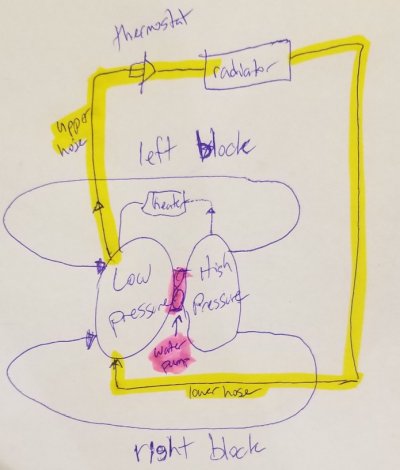Hello all! Newbie here. I'm urgently trying to get my "vintage" 1978 Dodge motorhome running, and it's got overheating issues. It's running a Mopar 440 on all 8 cylinders and goes down the road fine, but it's getting too hot. 230 on undulating hills at say 60mph+/-, and 260+ on long steep uphill.
The radiator isn't original, but it's about the right size. It also has two electric fans built in with a switch to turn them on (system is an add-on it seems).
The fan clutch seems fine--a buddy suggested trying to stop it from turning with a newspaper, and it just shreds away.
It's supposed to have a jacketed thermostat, but it's just got a normal one--availability issue. The reason for the jacketed one is to limit the coolant flow to the radiator apparently. However, I can't imagine that would make a 30-50 degree difference.
I flushed everything, and the radiator seems to be in good shape.
I don't know if there's a head gasket leak into the cooling, but I'm not getting any froth, maybe an occasional bubble I've seen, so if it is leaking, it's not much.
However... I can't for the life of me figure out what's pumping water through the radiator. It seems like it's passive!
I've attached an ugly sketch of what seems to be the coolant circuit. You'll notice that both the top and bottom radiator hoses go to the low pressure side of the water pump housing (i.e. the back).
Here's links to the water pump housing as well on 440source:
http://www.440source.com/1001074.jpg
http://www.440source.com/1001075.jpg
(3rd one down on this page: http://www.440source.com/wpumphousings.htm)
Any thoughts? Or am I missing something with regard to the water pump housing?
Thanks!
The radiator isn't original, but it's about the right size. It also has two electric fans built in with a switch to turn them on (system is an add-on it seems).
The fan clutch seems fine--a buddy suggested trying to stop it from turning with a newspaper, and it just shreds away.
It's supposed to have a jacketed thermostat, but it's just got a normal one--availability issue. The reason for the jacketed one is to limit the coolant flow to the radiator apparently. However, I can't imagine that would make a 30-50 degree difference.
I flushed everything, and the radiator seems to be in good shape.
I don't know if there's a head gasket leak into the cooling, but I'm not getting any froth, maybe an occasional bubble I've seen, so if it is leaking, it's not much.
However... I can't for the life of me figure out what's pumping water through the radiator. It seems like it's passive!
I've attached an ugly sketch of what seems to be the coolant circuit. You'll notice that both the top and bottom radiator hoses go to the low pressure side of the water pump housing (i.e. the back).
Here's links to the water pump housing as well on 440source:
http://www.440source.com/1001074.jpg
http://www.440source.com/1001075.jpg
(3rd one down on this page: http://www.440source.com/wpumphousings.htm)
Any thoughts? Or am I missing something with regard to the water pump housing?
Thanks!

